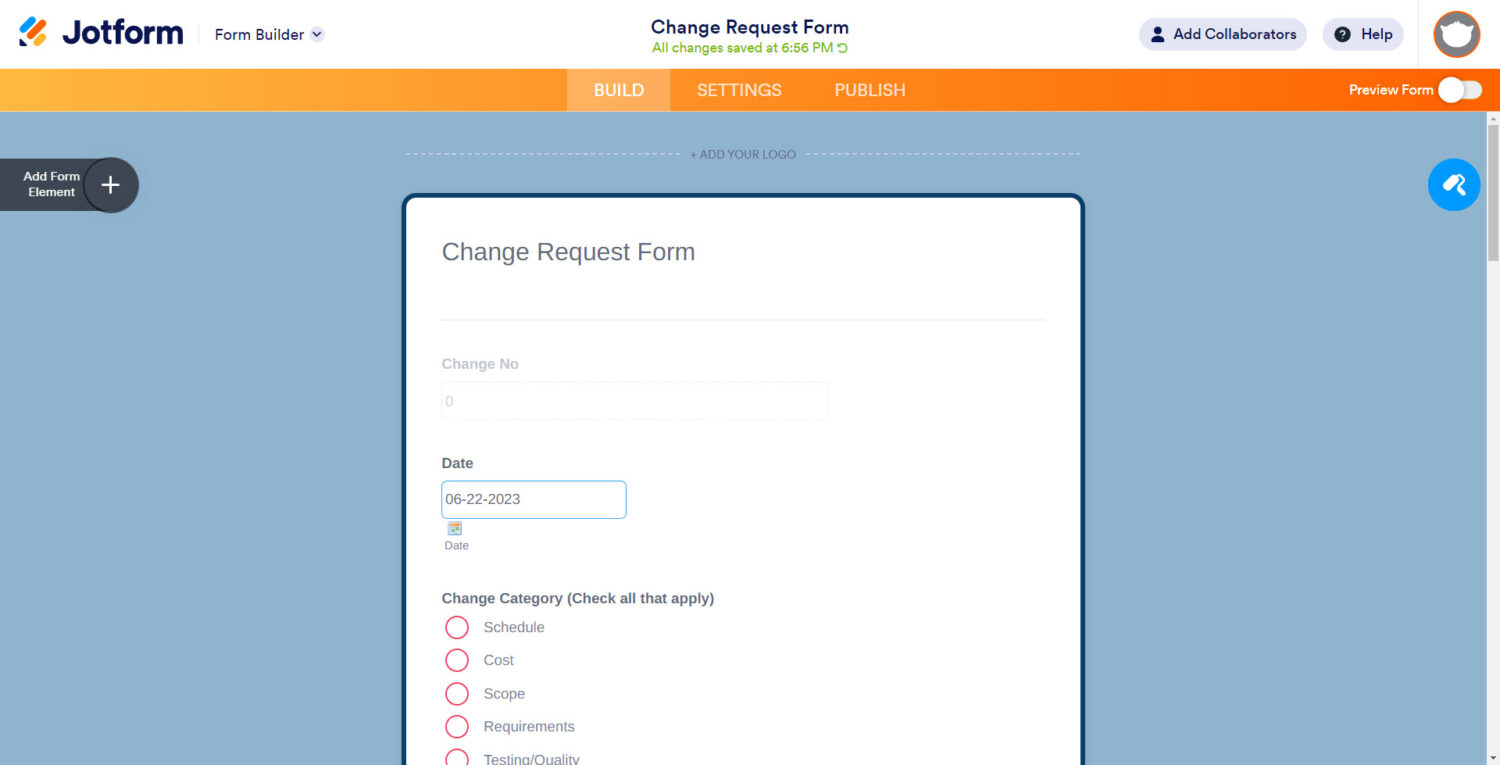A change management plan enables your business to evolve constantly and embrace new technologies and marketing practices to align with the dynamic market. If you do not, you risk stagnation or sunsetting the business.
If you own or manage a business, you must learn how to initiate, implement, and analyze a change management plan. According to a recent research report from WalkMe, 79.7% of businesses expressed their need to adapt to change every five years or less. However, merely 34% of those change drives succeeded.
The statistics of change management show that the process is challenging. But you can master it by reading this article until the end.
What Is Change Management?

Change management is the systematic approach to implementing and navigating organizational changes effectively. It includes plans to anticipate roadblocks, mitigate those bottlenecks, and guide the organization through a successful transformation.
The change or transformation could include anything from replacing the existing email app with a new one to completely changing your business’s products and services.
Mainly, businesses rely on the HR department or a third-party consultant agency for anticipated business transformation. This creates a distance between the change and the business managers, supervisors, and team members. However, the best way to achieve a successful transition includes involving every affected individual and team. Investing in change management certification training can equip leaders and employees with the necessary skills to navigate transitions effectively, ensuring smoother adoption and minimal disruptions.
Role of Change Management in Organization’s Success
Change is unavoidable in today’s economic and market conditions. Organizations that effectively adopt such market transformations are likely to thrive. Here comes a change management plan. It ensures a foolproof strategy to implement the change and avoid friction from employees, vendors, contractors, etc.
If the change demands extra effort and skills from employees or contractors, this plan helps you drive such results. This business management concept enables you to include the top to bottom-line employees in all the stages of transformation so they understand the criticality of the change.
Furthermore, change management enables your business to adapt to drastic changes in the market, workforce, or economy so you can stay operational.
Benefits of Change Management
- Your business can proactively address resistance to change and ease potential roadblocks to a smoother transition.
- Setting clear goals for change initiatives enables you to track progress and measure the effectiveness of your business transformation efforts.
- You can create a change management plan. Standardize it and save it for future business transformation projects.
- Change management addresses multiple aspects of change, including people, processes, and technology. Thus you can ensure a balanced and comprehensive approach to business transformations.
- During a change management process, you can provide adequate support, training, and guidance to existing employees to enhance their productivity.
The Change Management Plan and Its Components
A change management plan is the blueprint for all business transformation projects. It outlines the steps needed to enforce the change across the organization. It also includes workflows for communication, technology utilization, implementing new business apps, and so on. Find below the components of such a plan:
#1. Scope
In the scope, you must define the boundaries and extent of the change. You should outline the specific areas, departments, or processes that will change due to the transformation. Moreover, when you clearly define the scope, it helps establish a focused and manageable change effort.
#2. Objectives

You should outline the desired outcomes or goals that your organization aims to achieve in the Objective. Follow the SMART strategy to create your objectives so you can assess performance easily. Objectives may include improving business operations’ efficiency, enhancing customer service satisfaction, or implementing new technologies.
#3. Roles
A change management project must consist of the following roles:
- A change management professional
- Sponsors or business stakeholders who issue budgets and monitor all business changes
- Team leaders and workforce managers who will encourage the employees to accept the change
- Project managers create tasks and assign tasks to teams
- Training and development manager to train the workforce
#4. Change Impact Assessment
You must conduct an organization-wise or department-wise assessment of the impacts the change will create. For this, you can draft a change announcement and email that to all the employees along with an online form. Ask the employees to share honest feedback on the planned change, so your team can create an impact assessment report for the change sponsor.
#5. Risk Assessment
The Risk Assessment component involves determining the potential risks associated with the change and the following:
- Evaluating the likelihood of the risks
- Impact of such risks
- Developing strategies to mitigate such risks
How to Plan and Implement a Change Management Plan
- Clearly define the objectives and scope of the change management plan.
- Identify key stakeholders and involve them throughout the stages of transformation.
- Develop a detailed plan outlining the steps, timeline, and resources required to implement the change.
- Convey the change effectively, addressing concerns and highlighting the benefits.
- Provide support and training to employees to facilitate a smooth transition.
- Monitor progress and adjust the plan as needed
- Address all issues and bottlenecks that arise during real-time implementation.
- Evaluate the outcomes and learn from the experience to continuously improve future initiatives.
Change Management Templates
With a change management template, you do not need to plan everything from scratch. You can simply use any project management tool with a business transformation template to get started.
Many project and work management software developers research and standardize change management plans for businesses. Then, they post those plans as templates online or within the software. So, it is quite easy to source free or paid templates to manage the upcoming change in your business.
Importance of Templates
- Such templates help you save time and effort
- You also get a professional format you can use
- Free templates save you fees incurred from outsourcing the task to a consultant
- Templates of various formats, graphics, and creatives are available to choose from
- Software-based templates automatically integrate with your change management tool
#1. Change Management Roadmap Template

monday.com has an easy-to-customize and prebuilt change management roadmap template you can use. It comes with the milestones, tools, and processes you need to implement a change. If you need to present an overview of the whole transformation process, use this template.
#2. Change Management Communication Template

You shall also need to create a communication plan for the upcoming changes you wish to make in the business. It helps to reduce disagreements among the employees. To organize, standardize, and save it for the future, you can use a communication template for change management from Smartsheet. It is in Google Sheets, and you can download it as an Excel spreadsheet if you work on Microsoft 365 solutions.
#3. Change Request Template

A change request is a document you can use to track ongoing business changes. It is an effortless method to record all change requests. It tracks the following:
- Description of the requested change
- Benefit or reason for the change request
- Technical changes being requested
You can use this change request form template for free from Jotform. There are two ways to edit this form: sign up for a paid Jotform account or edit anonymously for free.
#4. Change Control Process Template

A change control template is similar to a change control request format. The only difference is you need to be more specific about the change in the former. Change process control focuses on how to implement the change aspect. Thus, approvers can see the big picture of the change before approving or denying it. You can use this Miro template to create a change control process.
Useful Software to Plan Change Management
#1. Whatfix
If you are doing change management planning, check out Whatfix now. It is a reliable tool to manage business transformation at an enterprise level. Its features include the following:
- Pop-up: Send announcements directly on employees’ screens
- Self Help: Create videos, links, and flows for the upcoming change so employees can learn
- Beacon: Business managers can create content without involving the IT team
#2. Freshservice
Looking for controlled IT change management? You should try Freshservice. The tool enhances the change rollout process and minimizes business impacts due to the change. Also, you can integrate the process with configuration, incident, and asset management processes. The tool lets you create a workflow to visualize the status of the transformation in phases like Planning, Awaiting Approval, Pending release, Pending Review, etc.
#3. Wrike
Wrike is ideal to plan the process, use all techniques for business transformations, and implement in a hybrid work culture. It gives you full visibility into the techniques and tools of change management along with the process. The tool has graphical representations of goals, workflows, tasks, and people, which consists of a transformation plan.
#4. ServiceDesk Plus
ServiceDesk Plus helps you to configure the roles, statuses, types, and templates of the whole IT change management project. If you face any problems and bugs during the process, you can save them as a log. Also, there are automated workflows so you can automate repeated tasks of the change project. Not to mention its templates also include change management metrics to measure success.
#5. SysAid
SysAid’s tool for change management helps you to drive the business transformation process according to the Information Technology Infrastructure Library (ITIL) guidelines for change management. Its change management phases include data entry tabs for Change Details, Analyze, CAB Approve, Implement, Release, Review, Close, and History, all that ITIL’s guidelines demand.
#6. Change Management – WalkMe
WalkMe can help you implement a business transformation smartly by calculating the technology investment budget. Also, it analyzes whether this budget will sustain a long-term change so you do not need to go through frequent transformation drives. You should use this tool to gain a complete view of the change process and enhance the impact of the transformation.
#7. The Change Shop
You could choose The Change Shop during change management planning for affordability, integrated technologies, and better management of employee feedback. All functionalities come with one subscription. Interestingly, The Change Shop has developed a Change Simulator tool so you can create a few What-If scenarios before investing time, money, and effort.
#8. Giva
Simple change enablement software, Giva, offers an easy way to plan and track ITIL-based changes within an organized dashboard. You can create and enforce change control workflows so the management can vet and approve the change. Moreover, you can review all business transformation projects with mixed, successful, and unsuccessful results from a cloud-based app.
#9. The Change Compass
Do you want a tool for a graphical presentation of the impact of a planned change in a business? Try The Change Compass. It also enables you to create insights from additional data so you can modify the transformation strategy for maximum benefit. Moreover, you can swiftly roll out changes across departments without disturbing the business operations.
#10. Issuetrak
An advanced change management app, Issuetrak, increases the probability of business transformation success. It provides all the tools to request a change, review the request, and approve it. The tool helps you by offering a change management task manager, compliance control utility, automatic task assignment workflow, and forms to collect or provide feedback.
Change Management Best Practices
Find below the best practices you should follow when transforming your business:
- Choose relevant key performance indicators (KPIs) aligned with the proposed change.
- Document the “why” of the change, supported by data that appeals to stakeholders’ goals and interests.
- Specify measurable outcomes for each primary task or phase in the change management plan.
- Expect that you might need to retrain your workforce in the future.
- Document expectations, compare them to real-life outcomes, and use the insights to improve future change management processes.
- Centralize communication within the project management software for streamlined collaboration.
- Schedule regular check-ins with stakeholders and tests at critical milestones.
- Prepare backup plans to ensure readiness.
- Evaluate the individuals responsible for implementing the change and assign leadership roles to those more likely to follow through.
- Connect goals with tangible results that impact day-to-day operations to enhance employee understanding and acceptance of the change.
Conclusion
The pathway to change management is simple and linear if you implement the right plan. Also, do not overlook the need for employee engagement during the process. You might need smart tools to document, plan, and automate some of its phases, so check the change management tools mentioned above as well.
A business transformation will involve budget spending. So check out these spend management solutions suited for any business size and type.










